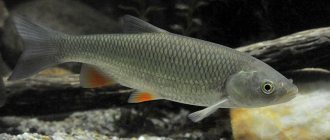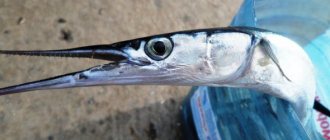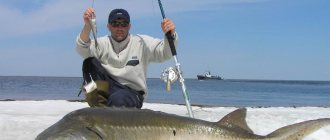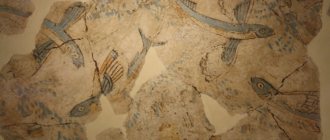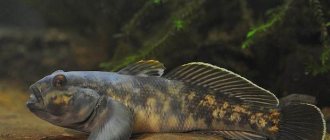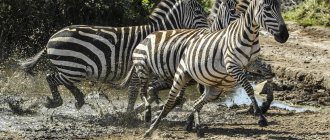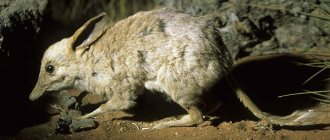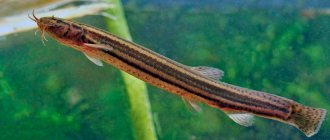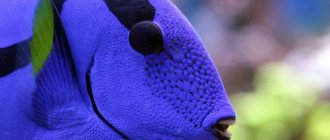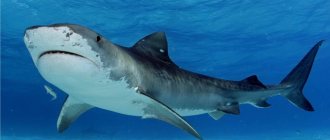Flounder is a fish whose characteristic feature is its flattened body. She is exotic and amazing, and her lifestyle is fascinating. Living at a depth of 20 meters, flounder smoothly glides along the bottom in search of food and, at the slightest danger, buries itself in sand or silt. Representatives of ray-finned fish can live and hunt at a depth of 200 m - that’s why flounder is so flat.
This flattened fish of the flounder family is unique and is of real value to anglers. Flounder lives in remote water areas and is distinguished by a calm character and an extremely interesting way of life.
Appearance of fish
Flounder is a ray-finned fish of the flounder family, the appearance of which directly depends on its habitat. The representative of the flounder lives both in freshwater reservoirs and in sea salt water. The characteristic difference between a sea fish and a river fish is its size and weight: a fish that has chosen the sea can easily reach a weight of 10-12 kilograms. There is a known case when fishermen caught a real giant weighing a trophy 100 kg.
The body shape of the fish is oval, and the body itself is flattened, which is typical for most bottom inhabitants. The fish has a small head and mouth, but its teeth are quite sharp. The tail part, in comparison with the body, is short. The bulging eyes of the flounder are located on the right side of the body, which is why the fish even received a second name - right-sided flounder.
Ichthyologists additionally identify several varieties of marine and river ray-finned fish. The following varieties of sea flounder are distinguished:
- halibut. There are 5 varieties of halibut. Large individuals can reach a length of 4 meters, and their weight can be about 300 kg;
- white-bellied flounder. The body length of the fish is half a meter. The fish itself is colored light milky, and the area where the eyes are located is brown;
- Sea flounder is distinguished by a greenish-brown body color and red-orange spots. The length reaches a meter, and the weight can reach up to 12 kg;
- Yellow-bellied flounder love cold waters. The body shape of this species is round and the coloring is yellowish. Weight does not exceed 2 kg. One of the striking features of this species is its scales with spines.
Unlike its marine counterparts, river flounder comes in only 3 types:
- Arctic flounder lives in cold waters, which is why the body of this species is noticeably elongated. The color of the fish is uniform brown. The body length does not exceed 50 cm, and the weight is 2.5 kg;
- Black Sea Kalkan. The characteristic difference of this species is the location of the eyes: on the left side. The color of the species is dominated by a dark olive hue, and the entire body is covered with spines. Kalkans are large fish and the average weight of one individual can reach 20 kg;
- The star flounder is distinguished by the fact that its eyes are located on the left side. The color of the fish is dominated by an olive tint, and there are wide black stripes on the fins. Unlike those individuals living in rivers, their weight reaches only 3-4 kg.
Lifestyle and habitat
This marine resident chooses a predominantly solitary lifestyle. He likes to spend his leisure time relaxing on the seabed. It can simply lie on the surface, or bury itself in the sand up to its eyes to observe the situation. It is very rare to see flounder rise higher than one meter from the seabed.
For fish it is a source of life, a home and a means of salvation from predators. Thanks to mimicry (the ability to quickly disguise itself as the environment, mainly stones and the bottom), it can quietly attack its victims or quickly hide from enemies.
Another important feature is the apparent slowness. It seems that due to its disproportionate and unusual body for a normal fish, flounder swims very slowly. Inexperienced fishermen claim that catching this aquatic inhabitant is quite simple, and its only method of escape is camouflage. However, no.
When a flounder feels safe, it swims slowly, as if it were simply being carried along by the current. Its movement resembles light wave-like movements, and its speed does not exceed 10 meters per hour.
But if a fish is caught from behind by a predator, it can develop very good speed. Thanks to its short tail, symmetrical pelvic fins and elongated dorsal and rear fins, it can easily hide from its pursuers.
In emergency situations, a flounder can easily jerk several meters at once, while leaving behind a powerful stream of water that will be directed to the bottom. This occurs due to the gill cover in the structure of the fish.
It is located on the blind spot of the body. A powerful jet will stir up the bottom, which will confuse the predator or disorient the prey. Thus, this technique is used to attack victims of flounder or to escape from larger and more dangerous sea fish.
Flounder lives exclusively in the waters of the Pacific Ocean. River species inhabit the bottom of cold rivers and bays. They can be found in the Dnieper, Bug, and Dniester rivers. Marine inhabitants are found mainly in the Black, Japanese, Baltic, Bering, and Mediterranean seas.
In the Sea of Azov, this type of fish is less common. Between the Black and Azov Seas there is the mouth of the Don River, where both freshwater and marine varieties of flounder thrive.
Despite the favorable salt level, it is still extremely rare to find them there. Modern poachers often catch these fish for industrial purposes or sale. It is worth noting that such activities allow them to earn good money.
Polar and northern white-bellied flounder, which prefer colder water, live only in the Kara, Okhotsk, Bering and White Seas. It is extremely rare to find it in the rivers Ob, Kara, Tugur and Yenisei. The fish loves silty and soft soils, in which they can easily hide, which is what these rivers have.
The yellowfin taxon is the most common flat fish of the flounder family and lives in waters with medium to high salt levels. Most often it swims at a depth of at least three hundred meters.
These fish are very popular in the industry. They inhabit the White, Baltic, Mediterranean Sea and other waters of the Atlantic. Southern white-bellied flounder is often found in the coastal zone of the Japanese and Red Seas.
Population and species status
The ray-finned population has been the object of close attention of environmental organizations for many years now. Research by ichthyologists has shown that the population is gradually declining due to fishing and environmental pollution.
The ecological situation is constantly deteriorating, and scientists are forced to observe with fear a terrifying trend in which 50% of the entire clutch of eggs survives. However, the status also depends on the type of flounder. Thus, in some species the process of extinction occurs slowly, while in others it occurs rapidly.
Ichthyologists have found that fish numbers are subject to cyclicality. This means that for an indefinite period of time the population of individuals increases and then rapidly decreases.
To prevent a decline in the number of flattened fish, scientists are calling for, at a minimum, reducing the consumption of flounder. They also advise thinking about what harm humanity causes to the environment every day and how many fishermen catch fish every day.
Types of flounder
The sixty currently known species of flounder are grouped into the main twenty-three genera:
- Spiny flounder (Acanthopsetta), including Spiny flounder (Acanthopsetta nadeshnyi) or Reliable flounder;
- Arrowtooth halibut (Atheresthes), including Asian halibut (Atheresthes evermanni) and American arrowtooth halibut (Atheresthes stomias);
- Sharp-headed flounder (Cleisthenes), including Herzenstein's flounder (Cleisthenes herzensteini) and Sharp-headed flounder (Cleisthenes pinetorum);
- Warty flounder (Clidoderma), including Warty flounder (Clidoderma asperrimum);
- Eopsetta, including Eopsetta grigorjewi or Far Eastern flounder, and Jordan's Flounder (Eopsetta jordani) or California Eopsetta;
- Long flounder (Glyptocephalus), including Red flounder (Glyptocephalus cynoglossus), Far Eastern long flounder (Glyptocephalus stelleri) or Steller's smallmouth;
- Halibut flounder (Hippoglossoides), including Japanese halibut (Hippoglossoides dubius) or Japanese flounder, Northern halibut (Hippoglossoides elassodon) and Ruff flounder (Hippoglossoides platessoides), and Bering Sea flounder (Hippoglossoides robustus);
- Halibuts (Hippoglossus), or turbots, including Atlantic halibut (Hippoglossus hippoglossus) and Pacific halibut (Hippoglossus stenolepis);
- Two-colored flounder (Kareius) and Two-lined flounder (Lepidopsetta), which includes White-bellied flounder (Lepidopsetta mochigarei) and Northern two-lined flounder (Lepidopsetta polyxystra);
- Limanda, including Yellowfin Flounder (Limanda aspera), Yellowtail Flounder (Limanda ferruginea) and Ruffed Flounder (Limanda limanda), Longsnout Flounder (Limanda punctatissima) and Sakhalin Flounder (Limanda sakhalinensis);
- Arctic flounder (Liopsetta), including the Northern flounder (Liopsetta putnami);
- Oregon flounder (Lyopsetta);
- Smallmouth flounder (Microstomus), including Microstomus achne, Smallhead flounder (Microstomus kitt), Pacific smallmouth and Microstomus shuntovi;
- River flounders (Platichthys), including Star flounder (Platichthys stellatus);
- Flounder (Pleuronectes), including Yellow sole (Pleuronectes quadrituberculatus);
- Hardhead flounder (Pleuronichthys), including Pleuronichthys coenosus, Horned flounder (Pleuronichthys cornutus);
- Spotted flounder (Psettichthys);
- Winter flounder (Pseudopleuronectes), including Yellowstripe flounder (Pseudopleuronectes herzensteini), Schrenk's flounder (Pseudopleuronectes schrenki) and Japanese flounder (Pseudopleuronectes yokohamae).
Also distinguished are the genus Dexistes and the genus Embassichthys, represented by the Deep-sea Embassichthys bathybius, the genus Hypsopsetta and Isopsetta, Verasper and Tanakius, Psammodiscus and Marleyella, Parophrys ) and Black Halibuts (Reinhardtius).
This is interesting! Halibut is a representative of the largest flounder in size and inhabits the depths of the Pacific and Atlantic oceans, and the lifespan of such a predatory fish can be half a century.
Return to content
Character and lifestyle
Flounder spends its entire life at the bottom, where it buries itself in the sand and serenely dozes. Flounders are calm and, despite their status as a predator, prefer to hunt without making any effort. Adults are rarely active and prefer to hunt from ambush.
Wriggling in wave-like movements, the fish buries itself in the sand and soil, where it lies motionless, waiting for a passing victim. Color also plays a key role in the hunting process. The body color of a fish can also change depending on its environment (mimicry). Feeling threatened, the flounder rises sharply, turns over on its side and swims to a safe place, where it also buries itself in the sand.
Habits and lifestyle of flounder
Young individuals are no different from ordinary round fish, however, with age, the body of flounder-like fish becomes flattened, and the eyes move to one side. The shape of flounders provides them with good camouflage: to protect themselves from predators, they lie on the bottom and merge with the ground.
Since representatives of this species move along the bottom, their lower side is rougher and rougher, resembling fine sandpaper in structure. Individuals also know how to bury themselves in sand, in which case only their eyes remain on the surface.
Some species also have a high ability to change the pigmentation of their body to match the color of the bottom.
What does flounder eat?
The basis of nutrition consists of crustaceans and other types of aquatic inhabitants. Basically, flounder prey on those who live at the bottom of reservoirs or close to it. However, some species rise to the upper water layers during feeding.
Flounders have also been spotted in the Mariana Trench at a depth of 11 kilometers.
Flounder breeding
When breeding, it produces a huge amount of eggs. During spawning, she can leave up to several million eggs, but not all fry reach sexual maturity.
The first few weeks the fry are no different from other fish species, but at the age of 4-6 weeks they sink to the bottom and become more like adults.
Natural enemies of flounder
Humans have become the main enemy at the moment: up to a ton of individuals of various species are caught every day all over the world.
Among natural enemies, scientists name conger eel and halibut, which, although according to some classifications it belongs to its subspecies, competes with its other species.
Habitats
Each species has a typical habitat. Some species even migrate when unfavorable conditions arise. The most striking example is the migration of the Black Sea flounder from the Sea of Azov to the mouth of the river. Don. The reason for this migration was salty waters and the shallowing of rivers flowing into the sea.
Freshwater individuals prefer lagoons, lower reaches of rivers and bays. The Yenisei, Ob, Kare and Tugura are the most favorable places where flounder lives. These rivers are distinguished by soft and silty soils, which ray-finned fish adores so much. Migration from salt waters to fresh waters and vice versa is not a problem for some members of the flounder family. Some species of flounder get along well both in the marine environment and in estuaries.
Cold-resistant representatives of flounder prefer to live in Arctic latitudes. The native home for such fish is the Barents, White, Bering, Kara and Okhotsk seas. However, cold-resistant individuals can also migrate from one water to another. Some types of cold-resistant fish prefer the waters of the Pacific Ocean. Often, northern flounder can swim into the Japanese, Okhotsk, Bering and Chukchi seas.
Nutritional value of flounder
The nutritional value of flounder meat is that it does not contain carbohydrates. For 100 gr. the product is about 15 grams. proteins, 3 gr. fat Fish also has a high content of iodine, Omega-3, vitamins (D, E, B, A) and pantothenic acid. The protein contained in fish meat is perfectly absorbed and processed. Therefore, representatives of the flounder family are used in the preparation of various health-improving diets.
What does flounder eat?
Each species of flounder goes hunting at completely different times of the day: during the day, in the evening or at twilight. The fish diet is varied. Flounder can be called a predator, since the fish feeds only on animal food.
The menu for young and adult flounder is slightly different. The usual diet of a ray-finned juvenile includes:
- caviar;
- crustaceans;
- benthos;
- worms;
- larvae;
- plankton;
- amphipods.
Adult fish prey on the following underwater inhabitants:
- worms;
- echinoderms;
- small fish;
- crustaceans;
- invertebrates.
One of the delicacies, according to flounder, are small-sized shrimp and capelin. Since most of the time flounder lies at the bottom, the favorite dish is small fish, hunting for which does not require special skills. Flounder snatches small fish with sharp jaws as they swim by, unaware of the predator's location.
Flounder diet
Depending on the species characteristics of the taxon, peak feeding activity may occur at dusk, night hours, or daylight hours . The diet of flounder consists of food of animal origin. Young flounder feed on benthos, worms, amphipods, as well as larvae, crustaceans and eggs. Older flounder individuals prefer to feed on brittle stars and worms, many other echinoderms, as well as small fish, some invertebrates and crustaceans. Representatives of the family are especially partial to shrimp and not too large capelin.
Thanks to the lateral position of the head, the flounder quite quickly gnaws from the ground small mollusks living in the thickness of the sea or river bottom. The strength of the flounder's jaws is so great that such a fish easily and quickly deals with the thick-walled shells of the cores, as well as the shells of crabs. The high value of the family members is largely determined by the balanced diet of high-protein foods.
Return to content
Reproduction and lifespan
Under ideal conditions, representatives of flounder fish can live more than 25-30 years. However, in the wild the situation is different: fish rarely live beyond 20 years, since they are constantly surrounded by threats. These could be predators, environmental disasters, or fishing. The last reason is the most common.
The breeding season is individual for each flounder species. The differences are based on habitat, the onset of spring, climate, sudden changes in temperature, nutrition and even warming of the water. For cold-resistant individuals, the best period is the beginning of January and the end of February. Other flounders may begin the breeding process in the summer (from mid-July to late August). These types include large diamond and turbot.
The breeding process is impossible if the flounder has not reached puberty. Males, as a rule, are ready to spawn when they reach three years of age, and females - when they reach one year. Puberty also depends on the environment. The ability to spawn may appear later if the flounder lives in unfavorable conditions and experiences problems with nutrition.
Flounder is characterized by increased fertility, so during one reproduction process it produces from 1 to 2 million eggs. These eggs can move independently, which is why they often end up in different points of the reservoir or even move to another one. As a result, most eggs of a freshwater species die when they find themselves in salt waters, and vice versa.
Sexual dimorphism
A characteristic difference between a female and a male is the size of the fish. Females, unlike males, have much greater body mass and length, and their weight can be almost 2 times greater than that of males. Moreover, the distance between the eyes of males is significantly less than that of females.
The shape of the fish’s body also plays an important role in determining sex. In females it is round, and in males it is oval or diamond shaped. In addition, males are also distinguished by their longer pectoral and dorsal fin rays.
Social structure and reproduction
Photo: Sea flounder
As already noted, flounders prefer a bottom solitary existence. The spawning time for each species is individual, it depends on the level of warming of the water column and the onset of spring. The general breeding season for flounder runs from February to May. There is an exception to this range. For example, a variety such as turbot enters the mating season from April to August in the waters of the North and Baltic seas. Arctic flounder spawns in the icy Kara and Barents seas from December to January.
Different species of flounder become sexually mature between three and seven years of age. Females of a larger number of species are very fertile, so one clutch can contain from 0.5 to 2 million eggs. Basically, the incubation period does not exceed two weeks. For spawning, fish choose deep-sea coastal areas with a sandy bottom.
Interesting fact: Flounder fry have the usual appearance for fish; they are not immediately born flat and have symmetry on both sides.
As they grow up, fish gradually transform, becoming similar to their parents. Their eye, located on the left or right, moves to the side of the second eye, this part of the fish becomes the upper one, and the eyeless side belongs to the belly, the skin of which becomes rough, because. used for sliding along the bottom. At first, benthos and zooplankton predominate in the diet of young animals.
It should be added that some species spawn at impressive depths of fifty meters, because the eggs have increased swimming ability and do not need to be attached to any hard surface. The average life span measured for flounder is quite long, it is about 30 years, but fish that survive to this point are considered very rare, because there are many enemies and negative factors on their way.
Natural enemies
Despite the first-class camouflage skill, the fish is forced to flee and beware of other inhabitants of rivers and seas. These ill-wishers attack flounder or destroy the eggs that the fish diligently lay.
Ichthyologists have identified a list of enemies that pose a danger to ray-finned fish:
- acne;
- shark;
- Human;
- halibuts.
In the spring, a female flounder lays up to 10 million eggs. Young fish are distinguished by the absence of characteristic asymmetry and swim sideways. They are naive and defenseless, so in most cases they become prey for individuals of other species.
Natural enemies of flounder
Photo: White flounder
Although flounders have excellent camouflage talent, which helps them go unnoticed, the fish still have enemies. One of the ill-wishers are eels, which are not averse to snacking on flat fish. In addition, large halibuts attack their flounder relatives without a twinge of conscience. Of course, the most vulnerable are inexperienced young animals, which can become a snack for any aquatic predators.
Sadly, the enemy of flounder is also man, who exterminates this fish because of its tasty, delicious, white meat, which is very healthy. Almost everywhere, flounder is constantly caught, both by individual recreational fishermen and on a large scale by fishing vessels. It is not surprising that fish rarely manage to live to the age of thirty, because a huge number of them die after getting caught in fishing nets.
In addition to the direct impact, people also have an indirect impact, negatively impacting the environment through their economic activities, which leads to a deterioration of the environmental situation as a whole. Many water sources (rivers and seas) become very polluted, so small fish, which serve as a food source for flounder, disappear from them. People can be called the most important and malicious enemies of flounder, because... Every day this fish is caught in tons. In addition to all of the above unfavorable situations for fish, one can also mention the fact that the survival rate of its eggs is not so high, so only half of them continue to exist.
Commercial value
Flounder is valuable to all anglers. Connoisseurs value saltwater fish more because they reach larger sizes compared to their counterparts from river reservoirs.
In the 1980s, global catches exceeded 200 thousand tons, but in the 21st century they dropped to 100 thousand tons. The Netherlands and Denmark are world leaders in archery fishing.
About 5 thousand tons of flounder are caught in Russia every year. They are usually caught using bottom trawls or snares. The market readily sells halibut and other varieties of flounder that live at a depth of 50-200 m in the seas. These individuals are valuable due to their meatiness and a huge number of useful components.
Methods for catching flounder
Flounder fishing is a fairly popular form of fishing. These bottom predators are caught almost anywhere where there is access to the sea. The most active bite occurs at night and early in the morning. During the daytime, bites may decrease or disappear completely. Fishermen also note the activation of fish after the storm.
It is best to look for flounder in areas with differences in depth and natural shelters. River and sea fish often gather at the confluence of fresh and sea water. Representatives of the species prefer a bottom covered with sand or small pebbles.
It is better to fish from the shore in the second half of summer or early autumn. During this period, flounders begin to actively feed before the cold weather. The fish comes closer to the shore and actively takes any bait.
In early spring, representatives of the species stay at a distance of 3–5 km from the coastline. Therefore, there is practically no bite on the shore. In winter, the fish loses activity and does not respond to bait.
Lures:
- shrimp;
- shellfish meat;
- anchovy;
- squid meat;
- sea worms;
- pieces of fish or chicken fillet;
- small fish;
- spoon;
- artificial, passive baits.
Representatives of the species gather in schools only during spawning, so during other periods the fish have to be searched for and caught one at a time. Spinning and bottom tackle are perfect for this. When choosing gear, you should take into account the fishing method, the size of the catch, the presence of salt in the water, the season and other factors.
For coastal fishing, hard spinning rods from 4 to 5 meters with a dough of at least 120–180 g are suitable. In the sea, you should pay attention to the fishing line; it must withstand loads of up to 10–15 kg and not deteriorate from salt water. It is better to install coils no smaller than forty.
For a sandy bottom you need to use anchor weights. An important condition is that the bait is on the bottom, since flounder rarely rises to the upper layers.
It is much more convenient to use several rods so that you can fish more areas at one time. If there is no bite, you need to move along the coastline or cast at different distances.
You should not immediately hook a flounder, as representatives of this species are characterized by slow swallowing of bait. To increase the interest of the fish, you can slowly drag the bait along the bottom.
Good results can be achieved with conventional bottom gear. To do this, it will be enough to assemble simple hooks and install them at different depths.
It is best to fish from a boat with a spinning rod from 1.2 to 2 meters. Baits of animal origin, spinners or silicone are used as bait. After casting, the bait is slowly passed along the bottom, taking long pauses. When fishing from a moving boat, it is worth considering the time it takes for the fish to react to the bait.
How to choose flounder
Before choosing fish, the buyer should study several subtleties in order to choose a product of the highest quality and not experience problems during the cooking process. Flounder suitable for purchase and cooking must meet the following requirements:
- meaty fillet;
- white fillet color;
- rough scales;
- Smooth surface;
- pink gills and clear eyes;
- sealed packaging without damage;
- taking the fillet to its original shape after pressing;
- fins and tail are always splashed with orange.
Please note: Chilled flounder should be inspected carefully. Buyers also need to pay attention to the information on the packaging, the amount of ice and the expiration date. If the buyer is aiming to buy flounder with an ice glaze, then he should take into account that the glaze layer should not be too thick.
Often in grocery stores you can find a product with ice or snow in some areas. Such fish cannot be purchased, since this factor indicates that the product has been frozen multiple times. A suspiciously yellow color also indicates that the product is not fresh.
Eating flounder
All varieties of flounder have not too fatty, soft meat, which is valued by gourmets around the world.
The only disadvantage of these fish is the unpleasant odor that can occur during cooking. You can remove it by peeling the skin and gutting the carcass.
Flounder does not have a pronounced fishy taste, which allows it to be included in the diet even for those who are particularly sensitive to this smell.
Food and calories
It is characterized by low fat content and high protein content. 100 grams of fresh fish contains only 90 kcal, and a boiled carcass contains 103 kcal per hundred grams.
The fried carcass has the highest energy value and fat content, which is not recommended to be eaten regularly. When fried, it has 223 kcal per 100 grams.
Useful and harmful properties
The fact that flounder fish contain a huge amount of useful substances is proven by their inclusion in a variety of healthy diets. Protein, which makes up a large percentage of meat, has a structure that is easily absorbed by the human body and does not overload it.
Flounder also contains Omega-3 and phosphorus salts. Among the vitamins contained in this fish are B12, A, D, E. They perform the following functions:
- Regulate the balance of water and salt in the body;
- Help convert glucose into energy;
- Strengthens bones and teeth;
- Helps form hemoglobin in the blood;
- Ensure proper functioning of enzymes;
- Improves muscle and brain function.
- Increase immunity and performance;
- Increases libido levels due to the content of aphrodisiacs in meat;
- Strengthens nails and hair;
- Rejuvenates the body.
Flounders themselves do not have pronounced harmful properties, however, like any other fish, they can accumulate harmful substances from their habitat, such as mercury or heavy metals.
By itself, it can harm people with kidney and liver problems, and those who are allergic to its meat.
Taste and quality of meat
Flounder dishes are so healthy that they are included in various diets. They are easily absorbed by the body.
In the diet for treatment, they are used when postoperative recovery or recovery from illness is necessary. In addition, consuming omega-3 acids in food increases the rate of death of cancer cells.
Flounder meat is distinguished by its juiciness and tenderness, but when it is cooked, a specific smell sometimes appears.
In order to remove it, you need to peel off the skin of the carcass. To make this easier, you can first remove the skin from the light side, and then, after removing the head, fins, tail and entrails, pull the skin off the dark side of the carcass with a sharp movement.
Selection and storage
Depending on whether you choose a chilled or frozen carcass, there are certain selection criteria:
- The carcass should not have an unpleasant or too strong odor. It should smell like fish without any impurities or foreign notes in the smell.
- For chilled flounder, a method for determining its freshness by the density of the meat is also suitable. If you press your finger on a fresh carcass, the hole either does not form at all or quickly disappears. Otherwise, it is better not to take the carcass.
- For a frozen carcass, the rule for determining its quality is by the state of the glaze. The ice crust should not be too thick and should not have a suspicious odor, yellowish or other unpleasant color. Normally, glaze should make up no more than 5% of the weight of the carcass.
If you need the chilled flounder to last a little longer, you can cover the carcass with ice and put it in the refrigerator. This way it will keep for a couple of days.
Chemical composition and calorie content
Flounder has a number of useful components, which allows its use as food. The fillet has a rich chemical composition and low calorie content - only 90 kcal per 100 g. This fish is healthy, but has contraindications that may cause the product to be excluded from the diet.
Useful properties of flounder
Systematic consumption of fish helps to improve the functioning of all body systems and prevent the exacerbation of chronic diseases.
Other beneficial properties also include:
- strengthening the immune system;
- fight against diabetes;
- improving brain function;
- reducing the risk of developing dementia;
- recovery after a serious illness;
- improving the functioning of the reproductive system;
- restoration of psycho-emotional state.
Flounder fillet is rich in high-quality protein, so it is often recommended to be included in the diet menu. Fillet provides the body with the necessary energy and ensures a long-lasting feeling of fullness.
Dangerous properties of flounder
Despite a number of beneficial properties for the human body, flounder can also have a negative impact on health. That is why you need to use it carefully and no more than 100 grams per day. You should also remember that frying, pickling, drying and smoking “kill” the beneficial properties. In this case, the fish can, on the contrary, negatively affect the body.
The following factors are considered undesirable consequences of eating flounder:
- accumulation of harmful substances in the body;
- increased load on the urinary organs;
- formation of salt deposits in the articular system;
- fluid retention in the body, causing edema and weight gain.
Cooking fillet using one of the above methods is harmful to health. Fish prepared in such ways is especially contraindicated for those who suffer from chronic diseases and gastrointestinal diseases.
Origin of the species and description
Photo: Kambala
The flounder family is a class of ray-finned fish belonging to the order Flounders. These fish are called right-sided flounders because... their eyes are located on the right side of the head. Some fish species are characterized by right-sided (reverse) eyes. The fins located on both sides of the flounder's belly are completely symmetrical and have a narrow base. The flounder family consists of 60 species of fish, grouped into 23 genera.
Video: Flounder
Despite the fact that each species has its own individual characteristics, there are still common features that are characteristic of all flounder, they have:
- strongly flattened body;
- close-set eyes with a convex shape. Their movements can be multidirectional and completely independent of each other;
- unusual asymmetrical head;
- lateral line located between the eyes;
- a lopsided mouth and very sharp teeth;
- elongated fins equipped with many rays;
- the light blind side, which is covered by rough and dense skin;
- short caudal peduncle.
Flounder eggs do not have a fat drop, so they move freely in the water column (swim), sometimes developing in the upper layer. Only five species of the entire flounder family spawn bottom-dwelling eggs.
Interesting fact: Flounders have a special talent for camouflage, which manifests itself in changing the color of the skin to match the surface of the bottom; in this matter of mimicry, they can compete even with chameleons.
It is worth noting that fish of different sexes have a number of differences among themselves. Males are more miniature than females, have a longer distance between the eyes, and their first rays of the dorsal and pectoral fins are also longer than those of females.
Beneficial features
A huge number of dishes are made from the Black Sea flounder, it goes well with almost all vegetables, and is ideal for baking in the oven. In addition, it has excellent taste. The fish meat is not only very tender, it is also practically boneless. In terms of usefulness, flounder is no worse than salmon or trout, which are so popular among the people. The high content of many substances determines the usefulness of Kalkan for humans.
“Fish contains amino acids that help lower blood cholesterol levels. Flounder contains many minerals and trace elements necessary for humans. Fish also contains a large amount of iodine” (Igor Artamonov, Russian chef).
Vitamin A, which is abundant in the Black Sea Kalkan, is very important for the human body. It improves vision by increasing the ability to perceive color differences. Improves healing of damage. Strengthens the immune system, reducing the risk of infectious diseases. Reduces skin aging. Increases resistance to cancer, increases a person’s energy and resistance to disease.
Vitamin B strengthens the nervous and cardiovascular systems. It improves metabolic processes, is useful for the gastrointestinal tract and endocrine secretion. Like vitamin A, it protects the body from the influence of negative atmospheric factors.
Acids from the Omega-3 group protect internal organs from destruction, fight nervous disorders, improve hormone synthesis, heal joints, and improve the functioning of the immune system.
Due to its low calorie content, tasty Black Sea flounder is recommended for food in various diets.
Photo of flounder
Read here Brook trout - choice of tackle, bait and bait for fish. Professional tips on how to catch trout (100 photos + video)
Help the project, share on social networks 
0
How many eyes does a flounder have?
Flounder
(in the Arkhangelsk region, and not only there, the name more often sounds like
flounder
) is the common name for several species of flat sea fish. It differs from other fish in its strongly flattened body and the location of its eyes on one side. The side facing up is more brightly colored and has fins. Has the ability to mimicry. In the process of development from egg to adult, it swims like all ordinary fish. However, upon reaching maturity, the flounder gradually lies on its side and its eyes move to the other side.
Lives at the bottom of the seas, some enter rivers. Flounder is hunted for its tasty meat. Turbot (Rhombus maximus), found in the Atlantic Ocean and Mediterranean Sea; Flounder (Rh. maceoticus), in the Black and Azov Seas; Glossa (Platessa flesus), in all European seas; salt (Solea vulgaris), in the North Sea; in the Mediterranean, Black and Azov - sea tongue (Solea nasuta). In the North of Russia, along Murman, and Kamchatka, the commercial fish of this family is halibut (Hippoglossus vulgaris), reaching 3 meters in length.
YELLOW-BELLY FLOUNTER (Platessa guadrituberculata)
The eyes are located on the right side of the body. The diameter of the eye is equal to or greater than the length of the snout. The left (blind) side is lemon yellow. Behind the left (upper) eye there are 5 prominent bony tubercles, sometimes there are 4 or 6. The body is wide, covered with smooth scales. The height of the caudal peduncle is greater than its length. The lateral line is slightly curved in front.
Distributed in the Bering and Okhotsk seas and, especially off the coast of Kamchatka, where the most abundant flounder banks are located between the mouths of the Ozernaya and Khariuzovaya rivers. In the Sea of Japan (Tatar Strait, between Dekastri Bay and the city of Alexandrovsky). Single - in Peter the Great Bay.
Yellow-bellied flounder is a bottom-dwelling fish that avoids desalinated waters and sticks to the cold and temperate waters of the Pacific Ocean.
Spawns at a depth of 100-150 m, at a temperature of +0.4°C. Spawning begins in March-April and ends in May. The eggs are buoyant like all flounders. The diameter of the eggs is 1.9 mm, with a grooved shell. Females reach 60 cm in length (absolute) and 3 kg in weight; males - 50 cm. In commercial catches, the average length of the fish is 36-39 cm. It reaches commercial size in the fifth year of life.
During the spawning period it feeds little, but after it it feeds more. Mainly feeds on invertebrates, small crustaceans and brittle stars. In the Tatar Strait it stays from May to October, at a depth of 20-80 m. Moreover, large adult specimens stay in deeper places, and juveniles prefer shallow waters with sandy soils. By winter, flounder migrates south and to greater depths.
There are about 10 species of flounder in the Red Sea, but the most famous of them is the “dag Moshe Rabbeinu” Pardachirus memoratus - Moses flounder (in English it is also called Finless sole). This small, 25 cm long fish lives in the coastal zone of the western Indian Ocean from the Red Sea to Ceylon and South Africa at a depth of up to 15 m. It feeds on invertebrates and spends most of its time buried in the ground, so that only its eyes protrude out. What did this little fish do to deserve the middle name Moiseevna? One version, explaining the peculiarities of the shape of the flounder, takes us back to the Exodus from Egypt. The Torah tells us that the Jews fleeing from Pharaoh stopped in front of the Red Sea. Ahead is water, behind are Egyptian pursuers. And G‑d said to Moshe. “And you lift up your staff, and put your hand on the sea, and cut it, and the children of Israel will pass through the sea on dry ground” (Beshalach 14:16). So, according to one legend, a bottom fish fell under Moshe’s cutting staff, which he, unwillingly, cut in half, giving it a hitherto unprecedented shape, as a result of which the world’s ichthyofauna was enriched by the order of flounder-like fish.
Another legend explains the origin of the typical coloration of flounders. So, one day Moshe decided to fry fish. One side was nicely browned, but there wasn't enough oil for the other side. Moses became upset and threw the undercooked fish into the Red Sea. The half-fried fish miraculously remained alive, but since then the eye side of flounders is dark (fried), and the blind side (the one on which the fish lies) is light. In general, both stories do not contradict each other and Moshe could have dealt with the flounder twice, first giving it shape and then coloring. But today, biologists have discovered properties in this fish that are so unusual, one might even say miraculous, that the connection between the “Flounder Moiseevna” and Moshe Rabbeinu, the great prophet and miracle worker, has become much more substantiated than the creators of ancient legends could have believed. All flounders are edible fish, and our heroine is no exception, although not the most important, but quite a worthy object of local fishing. The natives willingly eat it fresh, but they also noticed that predatory fish disdain this flounder. Biologists have found that at the base of its dorsal and anal fins there are glands that secrete a mucous substance that repels predators, including sharks. Studies in laboratory pools and in the open sea have confirmed that the mucus of the Moshe flounder, once in the water, repels sharks for 10 hours. Israeli biochemist Eliyahu Zlotnikov and his colleagues deciphered the structure of the toxin that is part of the mucus. This poison, called pardaxin, is a long protein molecule made up of 162 amino acids. The mechanism of its repellent effect was also found out - pardaxin changes the structure of cell membranes, as a result of which the sharks have difficulty breathing and blood circulation, so they run away from the flounder. It was then that hopes arose for the creation of a reliable repellent for repelling sharks, potent, but at the same time non-lethal, and “Kambala Moiseevna” for some time became very popular among shark fighters and shark lovers. But it turned out that pardaxin is very unstable during storage, and if it is dried, then only 30% of its effectiveness remains.
What is the difference between ruff flounder and regular flounder?
There are differences between ruffed flounder and ordinary flounder. Both fish are demersal, but live in different waters and at different depths. Hence the similarities and differences characteristic of each species.
Characteristic differences are described in the table
| Differences | Flounder ruff | Common flounder |
| Body Shape | elongated | high |
| Presence of scales | scaled | without scales |
| Coloring | brown | gray |
| Habitat depth | up to 500 m | up to 180m |
| Habitat | North Atlantic Ocean, Barents Sea, Kara Sea | Eastern Atlantic Ocean, White Sea, North Sea, Sea of Okhotsk, Baltic Sea, Black Sea and Mediterranean Sea |
| Spawning | migration to depth | stays in place |
| Taste | fatty, sweet | dietary, gentle |
| Cooking method | delicious in all forms | ideal for frying |
Appearance and habits
The first difference concerns appearance. The sea ruffe flounder is elongated and covered with scales. The body of the common flounder is shorter and taller, completely smooth.
The color of these fish also varies. The ruffed flounder is brown on top with dark speckles and has a light belly. The common flounder is gray in color with contrasting yellow spots along the back. The lower part of the body is yellow, also lighter than the back.
There are no significant differences in the diet and lifestyle of the species.
Both species are diurnal. They hunt small animals and bottom-dwelling fish. If live prey escapes, then the food consists of bottom algae and plankton.
Before spawning, sexually mature individuals of the ruffe flounder rush to the depths, where they reproduce and continue their lives. In contrast, ordinary flounder always remains in familiar conditions.
Habitat
Both species lead a benthic lifestyle, but live at different depths, which also distinguishes the species from each other. The ruffed flounder migrates from shallow to deep water throughout its life. The maximum depth where the fish feels comfortable is 500 meters. Common sea flounder predominantly inhabits coastal areas and does not go deeper than 180-200 meters.
Fish have different habitats, which determines their external differences and differences in habits.
The ruffed flounder is common in the northern waters of the Atlantic Ocean, the Barents and Kara Seas. Common flounder is found in the eastern part of the Atlantic Ocean, the White, North and Okhotsk Seas, and lives in the Black, Mediterranean and Baltic Seas.
Food preferences
Sea flounder preys on crustaceans, mollusks and worms that live on the bottom. Its diet consists of haddock and cod fry. It also feeds on the eggs of other fish, insect larvae, shrimp, and algae. She has powerful jaws and sharp teeth. There are no significant differences in the diet of ruffe and ordinary flounder.
Natural enemies
Flounder itself is a predator. She has natural enemies that are larger and stronger than her. Among them are stingray, halibut, eel, cod, polar shark. She often has to hide and hide, because life at sea is unpredictable and very dangerous. There is no difference in the enemies.
Diet
Flounder feeds very variedly. It can be classified as a predatory fish. The basis of nutrition consists of worms, mollusks and small crustaceans. But small fish that swim near the shelter are also often eaten. The fish does not like to leave it, so as not to become prey itself.
Despite the fact that flounder is a predator, fishermen prefer to use natural bait. To do this, they take worms or shellfish meat. For a fish to pay attention to its potential prey, it must be right under its nose. Otherwise, she is unlikely to come out of hiding, even to eat.
Kinds
River flounder
- long eared hedgehog
- Cross spider
- Reptiles
- 72 facts about plants
- Animals of Siberia
- 35 facts about giraffes
The species Platichthys flesus, large in population but poor in related taxa, has successfully acclimatized for permanent residence in fresh and slightly salty water. It is distinguished by a rounded body and spines on the lateral line. The sighted side has a dull brown or olive-brown color with chaotic yellow and dark specks. It will grow up to 3 kg with a body length of 50 cm.
For full development, the clutch of flounder must constantly receive a fresh supply of oxygen due to drift in the water column (pelagic eggs). But this is only possible in a dense salty environment (from 10 ppm). In freshwater rivers, the larvae do not maintain buoyancy, sink to the bottom and die, so the fish go to sea to spawn.
The cool Baltic is ideal for these purposes with a vast basin, low salinity (11-12%), a long coastline, moderate depths of 30-50 m and a rich food supply. The river species is also officially called the Baltic flounder due to its wide distribution in the coastal zone, inflowing rivers and the sea.
Star flounder
The species Platichthys stellatus lives in the northern waters of the Pacific Ocean (Bering, Okhotsk, Chukchi, Sea of Japan). The freshwater form inhabits lagoons, bays and lower reaches of rivers (150-200 km from the mouth). It has left-sided eyes, dark color (greenish, brown), wide black stripes on the fins and star-shaped spiked plates on the eye side. Due to its distribution, the taxon is also known as the Pacific river flounder. The usual size of the fish is 50-60 cm and weighs 3-4 kg. There are frequent cases of catching large individuals weighing 7-9 kg (75-90 cm).
Black Sea Kalkan
The fish is similar to flounder, but belongs to a separate family called Scophthalmidae. Inhabits the North Atlantic and the Black, Baltic, and Mediterranean seas. It grows over a meter in length and weighs up to 20 kg. It is distinguished by the left location of the eyes, its round shape and a large number of tuberous spines scattered over the entire surface of the brown-olive sighted side. In addition to the marine environment, it thrives in the lower reaches of the Dnieper, Southern Bug, and Dniester. Due to the increased salinity of the Sea of Azov due to the shallowing of the inflowing rivers, the Black Sea flounder has spread to the mouth of the Don. A smaller subspecies also lives here - the Azov diamond, which will grow in length to 40-45 cm.
Arctic flounder
A cold-resistant Arctic species (Liopsetta glacialis) with an elongated oval body of a uniform dark brown color and brick-colored fins. Prefers soft silty soil. Inhabits the Kara, Barents, White, Bering and Okhotsk seas. It reproduces in winter under ice, at negative water temperatures (up to – 1.5°C). Often the warm feeding season is spent in the low-salt lower reaches of Siberian rivers. Found everywhere in the Kara, Yenisei, Ob, Tugur.
Sea flounder
The salty environment is home to dozens of species of flat fish that thrive both on the shallow coastal shelf and at depths of several kilometers. They are characterized by a wide variation in size, body shape, fin color, sighted and blind sides.
Common sole
The basic taxon (Pleuronectes platessa), living in low- and high-salinity water (10-40%) at depths of 30-200 m, is an important commercial fish object. Inhabits the Eastern Atlantic, Mediterranean, White, Barents, Baltic and other seas. The main color is brown-green with reddish or orange spots. It grows up to 6-7 kg, maximum size up to 1 m. It has well-developed mimicry.
White-bellied flounder
Sea bottom fish that grows up to half a meter. The minimum commercial size is 21 cm. Features of appearance are an arched diluted lateral line, milky color of the blind side, brown or wheat-brown color of the eye side.
There are two subspecies:
- Southern white-bellied flounder (Lepidopsetta bilineata mochigarei) lives in the coastal zone of Primorye and the Sea of Japan.
- Northern (Lepidopsetta bilineata bilineata) - in the waters of the Kamchatka, Okhotsk and Bering seas. Both form large populations in Peter the Great Bay (southern Primorsky Krai) and the Strait of Tartary, which separates Sakhalin from the mainland.
Yellowfin flounder
A cold-loving species (Limanda aspera) from the genus Limanda, which is common in the Sea of Okhotsk, Japan and Bering Sea. Fish are plentiful off the western coast of Kamchatka and Sakhalin. Prefers depths of 15-80 meters, where it adheres to sandy soils. Other common names for the taxon - spiny limanda and red flounder - are given because of the spiked scales and rounded brown body framed by yellow-golden fins. The maximum size is 45-50 cm with a weight of 0.9-1.0 kg.
Far Eastern flounder
Collective name for a dozen taxa of flat fish. In addition to the yellowfin, star and white-bellied forms, there are two-lined, long-snouted, proboscis, halibut, yellow-bellied, warty and others. It is the northern territories that provide the majority of the world's catch of flounder.
Habitat
Kalkan is just one of 30 species of flounder that live in our seas. But there are not many places where kalkan are found. In addition to the Black Sea, these include only the Azov and Adriatic Seas, the Bosphorus, and the Sea of Marmara (its northern part). In search of food, flounder often swims into desalinated reservoirs near river mouths. But still, kalkan is mainly a sea fish.
It has been noticed that the flounder population in the Sea of Azov is declining not only due to unregulated fishing, but also due to the desalination of the Azov Sea that has been ongoing for a long time. There were attempts to breed Kalkan in other seas, but they ended in failure. Back in 1902, the fishing team of merchant Vorobyov caught 120 thousand flounder fry off the coast of Crimea.
Then, in special containers lined with ice, the fry were transported by train to Derbent. The fry released into the Caspian Sea never took root; they all died. Therefore, Crimean flounder is not found in the Caspian Sea. So Kalkan remained Black Sea, it was not destined to become Caspian.
Economic importance
Kalkan is a valuable commercial fish with very tasty meat, which is compared to chicken, but it is much more tender. Black Sea and Azov flounder are so popular that they are in unlimited demand among the population. Suffice it to say that in Turkey, a kilogram of Kalkan costs 15 dollars. But, being an iconic fish of the Azov and Black Seas, kalkan is practically unknown to a wide range of Russian buyers due to a decline in its population.
The history of Kalkan mining is quite sad. At first it was mined at a rate of several thousand tons per year. This level of catching remained until the 80s of the last century. In 1986, by decree of the USSR government, due to the depletion of fish stocks, its fishing was completely prohibited. Nowadays, this resolution has lost its force.
The technology for fishing for flounder flounder has been developed at a serious level. Fixed nets are used, which are installed along the migration route of the Kalkan. Unregulated fishing for Kalkan has a detrimental effect on its catastrophically declining population.
Amateur fishermen catch delicious Black Sea flounder using spinning rods from a boat, fishing nets, and nets. The best season for fishing is autumn; you need to fish at night or early in the morning before sunrise. But due to barbaric, uncontrolled fishing by seiners, kalkan has become a very rare catch for fishermen.
Everyone understands that in order to restore the Kalkan as a commercial fish, measures will be required to organize its industrial reproduction, including artificial ones. And here we need coordinated efforts of all countries of the Black Sea basin. Here Turkey sets an example for everyone, which has been growing Kalkan by farming method with great success for many years. In Russia, some institutes began work on artificial breeding of Kalkan, but for various reasons they were not completed.
At the VNIRO base, in the late 60s of the last century, they tried to breed flounder using artificial reproduction. “But the question of the prospects for organizing artificial reproduction and commercial cultivation of Kalkan remains open” (Proceedings of VNIRO). Now the time has come when delay could lead to the extinction of the Black Sea flounder as a species. We need to save him so that the flounder in the Black Sea is not lost.
